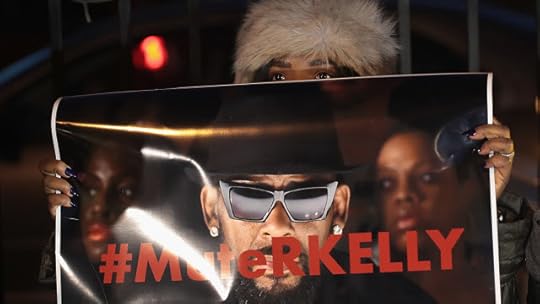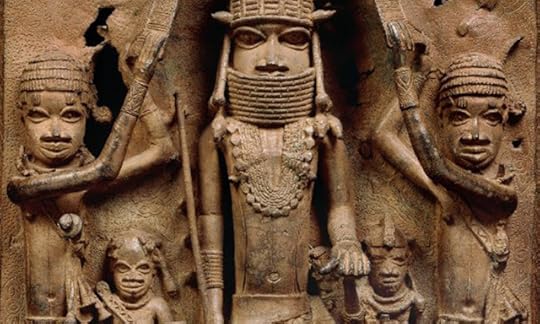Mark Anthony Neal's Blog, page 404
February 26, 2019
Cite Black Women S1:E5: Dr. Daina Ramey Berry: Slavery, Commodification and Black Women's Erasure
 '
Cite Black Women
founder Christen Smith interviews historian Daina Ramey Berry, the author of five books on gender and slavery in the United States. In this conversation we talk about the powerful and reflective work of writing about our collective past, the relationship between the commodification of Black women during slavery and the politics of citational erasure and the importance of reading our history and mentoring for Black women.Dr. Daina Ramey Berry is a specialist on the history of gender and slavery in the United States and Black women’s history. She is the award winning author and editor of five books and several scholarly articles. Her recent book, The Price for their Pound of Flesh: The Value of the Enslaved, from Womb to the Grave, in the Building of a Nation (Beacon, 2017) has been awarded three book awards.'
'
Cite Black Women
founder Christen Smith interviews historian Daina Ramey Berry, the author of five books on gender and slavery in the United States. In this conversation we talk about the powerful and reflective work of writing about our collective past, the relationship between the commodification of Black women during slavery and the politics of citational erasure and the importance of reading our history and mentoring for Black women.Dr. Daina Ramey Berry is a specialist on the history of gender and slavery in the United States and Black women’s history. She is the award winning author and editor of five books and several scholarly articles. Her recent book, The Price for their Pound of Flesh: The Value of the Enslaved, from Womb to the Grave, in the Building of a Nation (Beacon, 2017) has been awarded three book awards.'
Published on February 26, 2019 04:49
Building Worker Solidarity and Racial Equality on the Docks
'Historian Peter Cole examines the history of building labor solidarity and racial equality between dockworkers, in San Francisco, South Africa and beyond - as key participants on front lines of global capitalism, union members recognized the link between economic and social struggles, and their combined power. Cole is author of the book
Dockworker Power: Race and Activism in Durban and the San Francisco Bay Area
from University of Illinois Press.'
Published on February 26, 2019 04:40
February 25, 2019
Fashion Faux Pas and the Beast of Political Correctness: Meaning and Representation in the Age of Trump

Fashion Faux Pas and the Beast of Political Correctness: Meaning and Representation in the Age of Trump by Wilfredo Gomez | @BazookaGomez84 | NewBlackMan (in Exile)
We have reached our individual and collective limits! We can no longer have the rampant uninhibited distribution of images recalling nooses and blackface in the era of Trump! And rightfully so, given how the boundaries of the unacceptable or transgressive have been superseded with the rise of Trump’s America. At this point it is no longer a truism to pontificate at length about just how different Trump is from his predecessor: diction, vocabulary, temperament, respectability, diplomacy, and yes: simple and obvious as it may seem, blackness. But in the process, it would seem that we have become desensitized by the conflation of the credible and the incredulous, the critical and the comical, the poignand and that which is parody gone off the hinges. Nowhere was this most evident then when Saturday Night Live satirized the President (in a skit featuring then Candidate Donald Trump) in 2015 when he proceeded to pocket a check for $20 billion from Mexican 'president', played by Beck Bennett. There is a fine a line and we seemed to have lost our way. But where do we draw the line?
This is a question that arises in the aftermath of the controversy surrounding fashion house Burberry and their fashion faux pas, issuing an apology in light of one of their own models (Liz Kennedy) drawing attention to a piece of clothing (suggesting "Suicide is not fashion." and "Let's not forget about the horrifying history of lynching either") that appeared to prominently feature a “noose-like drawstring.” While the designer claims (Riccardo Tisci) they were inspired by a “nautical theme,” we want to raise awareness to a particularly sensitive time in our nation. In doing so, we raise the question, just where do we draw the line between representation and expression, critical engagement and flat-out rejection/public condemnation? This question is made all the more poignant in the aftermath and consequences of 2016 and the looming 2020 election.
For all intensive purposes there are seismic shifts that need to be wrestled with and they appear to exist somewhere in the liminal space between: one the one hand, we have Bernie Sanders’ recent offering that his “socialist” or “radical” views are now more mainstream vis-a-vis calls for reform with regards to health care, educational access and parity, and need for self-reflexivity about the role of capitalism in perpetuating such stark inequalities in society (a stark contrast to Trump’s SOTU address), and on the other, there is Jerry Seinfeld's dare we say distrust of political correctness as an inhibitor of public engagement (in public venues that are in today’s time also digital) whereby the prospects of possibility and potential are predicated upon boundaries and buttons being pushed, democratic publics participating, indulging, and sharing in access to spaces that constitute community for however temporarily constructed they may be.
Upon reflecting on these discourses of representation, respectability, and cultural moves, the analysis offered by said model (Kennedy) pointing out the signification of lynchings and suicides appear to be more out of touch and out of bounds than a missed call in crunch time when the game is on the line. The analysis of Burberry’s garment, finding a parallel in the imagery and imaginary of lynchings (a historical apparatus that implicates all in the original sin of chattel slavery) and the increasing occurrence of suicides on a national scale, does more to remind us of an exercise in semiotics befitting of Roland Barthes (the pseudo version), a scholar framing aspects of “covering” within high fashion, to invoke the work of legal scholar, Kenji Yoshino. It is true that the fashion world really needs to be cautious, exercising better judgement (and diversity...preferably from the macro of the boardroom to the micro of the labor that permits such exorbitant pricing for such hideous/exaggerated clothing) about what they are marketing.
We just witnessed American singer Joy Villa make the conscious decision to “dress up” as Trump's controversial “wall” complete with barbed wire shoulders and a "Make America Great Again" purse. All of this is not to ignore her attempts to both reconcile and rationalize such a choice for a broader public audience when prompted to do so (half-hearted appeals to mixed racial ancestry, “shared” political ideology, or the belief that one is being low-balled on the salary scale, doesn’t quite cut it in the analytical realm). Similarly, neither does the attempt to claim ownership over such a faux pas with the invocation of we are "deeply sorry for the distress" and "It was insensitive and we made a mistake." We see you Gucci...and your ugly ass overpriced clothes...FOH!
The panopticon is real right now as Foucault would surely attest to. Nothing is safe for the vigilance surrounding visual representation or language. But who exactly are these folks crying wolf on social media? Are they formally trained scholars with a particular knowledge base and critical lens that contextualizes, reflects upon, problematizes, then offers substantive analysis? Or is there some high and mighty collective of folk policing our boundaries via the digital -- a moral code police playing cultural critic or feigning cultural expertise? How many of us can honestly say that we would have picked up on the analogy of a noose or suicides had this point not been raised? We raise this point not to be dismissive of such views or ignoring the poignancy and powerful impact of voicing and sharing such perspectives, for they in fact, do create a dialogue. Rather we ask, are these moments of crying wolf premature?
We know how that story plays out (the boy who cried wolf that is) and we are seeing it play out again with the recent Jussie Smollett fiasco (a fiasco accompanied by the symbol and historical weight of a noose, and supplemented by the racial undertones of being othered, and the political overtones embodied and enacted by the phrasing, “This is MAGA country!”). Criticism and cultural analysis are vital to the pulse of a thriving democratic society, but when inadvertently mixed in a concoction promising to do good, we must ask ourselves if we are sacrificing substance in the name of well-intentioned attempts to raise the level of consciousness and social awareness, a claim Jay-Z made during his conversation with Dean Baquet of The New York Times -- we need no look further than Cory Booker’s initial twitter musings referring to Smollet’s attack as a “attempted modern-day lynching,” Kamala Harris’ echoing of similar sentiments, Bernie Sanders’ characterization of such an act of violence as a “racist and homophobic attack...a horrific instance of the surging hostility toward minorities around the country,” or Kirsten Gillibrand’s comments shared via twitter, "This is a sickening and outrageous attack, and horribly, it's the latest of too many hate crimes against LGBTQ people and people of color,"
The comments above represent a search for Truisms (Anti-Trumpisms) or value-laden truth systems that seek to expose and root out crises and paranoia (Trumpisms). Is this a fashion faux pas or a race towards enlightenment attempting to outdo the timestamp(s) of the modern media cycle? In the contemporary landscape wherein the political is personal, and the personal is political, where politics and cultural criticism collide, how do we account for and hold ourselves accountable for political correctness, while pushing one another towards greater vigilance working towards social awareness, compassion, diversity, inclusion, and democracy? You decide.
+++
Wilfredo Gomezis an independent scholar and researcher. He can be reached at gomez.wilfredo@gmail.com or via twitter at @BazookaGomez84.
Published on February 25, 2019 08:20
February 23, 2019
"The Yardstick Has Shifted": The Joys of Being Over 40
 'Hollywood would still have us believe that women over 40 are past their prime. But we brought in two women who are themselves very strong evidence to the contrary. Both have contributed essays to a new collection by 15 different authors called On Being 40(ish). The Takeaway host Tanzina Vega spoke with
Jill Kargman
, an author and creator of the Bravo TV series Odd Mom Out which aired for three seasons starting in 2015, she’s in her mid-forties, and
Sophfronia Scott
, a writer in her mid-fifties.'
'Hollywood would still have us believe that women over 40 are past their prime. But we brought in two women who are themselves very strong evidence to the contrary. Both have contributed essays to a new collection by 15 different authors called On Being 40(ish). The Takeaway host Tanzina Vega spoke with
Jill Kargman
, an author and creator of the Bravo TV series Odd Mom Out which aired for three seasons starting in 2015, she’s in her mid-forties, and
Sophfronia Scott
, a writer in her mid-fifties.'
Published on February 23, 2019 05:38
‘Moonlight’ Writer Tarell McCraney Hopes Audiences Leave His New Play ‘Full of Questions'
 'The hit Broadway play Choir Boy chronicles an African-American prep school and its star pupil, the choir boy, who happens to be gay. Written by Tarell McCraney, a MacArthur Fellowship recipient, the play explores themes not often addressed publicly within the black community or outside it. Jeffrey Brown sits down with McCraney to discuss what it means to bring important voices to the stage.' --PBS NewsHour
'The hit Broadway play Choir Boy chronicles an African-American prep school and its star pupil, the choir boy, who happens to be gay. Written by Tarell McCraney, a MacArthur Fellowship recipient, the play explores themes not often addressed publicly within the black community or outside it. Jeffrey Brown sits down with McCraney to discuss what it means to bring important voices to the stage.' --PBS NewsHour
Published on February 23, 2019 05:30
Visualizing Black America -- Whitney Battle-Baptiste and Britt Rusert on W. E. B. Du Bois's Data Portraits
 'When W.E.B. Du Bois wrote about the color line in The Souls of Black Folk, he lamented the racism that disenfranchised and discriminated against African-Americans in the 20th century. The split between blacks and whites that the color line represents is most often interpreted through Du Bois’ writing, but the famed sociologist and civil rights activist also put a visual to it. In 1900, Du Bois led a team of students and alumni from Atlanta University (now Clark Atlanta University) in designing a set of data portraits for the Exposition Universelle, a world’s fair in Paris. Among the images were 63 hand-drawn data portraits designed and created by Du Bois and his team. Britt Rusert and fellow UMass Amherst professor Whitney Battle-Baptiste, who is also the director of the W.E.B. Du Bois Center at the university, have co-edited a book compiling the portraits titled W.E.B. Du Bois’s Data Portraits: Visualizing Black America.' -- WABE
'When W.E.B. Du Bois wrote about the color line in The Souls of Black Folk, he lamented the racism that disenfranchised and discriminated against African-Americans in the 20th century. The split between blacks and whites that the color line represents is most often interpreted through Du Bois’ writing, but the famed sociologist and civil rights activist also put a visual to it. In 1900, Du Bois led a team of students and alumni from Atlanta University (now Clark Atlanta University) in designing a set of data portraits for the Exposition Universelle, a world’s fair in Paris. Among the images were 63 hand-drawn data portraits designed and created by Du Bois and his team. Britt Rusert and fellow UMass Amherst professor Whitney Battle-Baptiste, who is also the director of the W.E.B. Du Bois Center at the university, have co-edited a book compiling the portraits titled W.E.B. Du Bois’s Data Portraits: Visualizing Black America.' -- WABE
Published on February 23, 2019 05:21
February 21, 2019
Hiding From ICE In A Black Church
 'Facing deportation, this undocumented Mexican mother and her four kids found sanctuary in an African-American church. Almost 50 immigrants have taken refuge in sanctuary churches as of 2018. And this isn’t the first time churches have served as places of refuge from authorities.'
'Facing deportation, this undocumented Mexican mother and her four kids found sanctuary in an African-American church. Almost 50 immigrants have taken refuge in sanctuary churches as of 2018. And this isn’t the first time churches have served as places of refuge from authorities.'
Published on February 21, 2019 16:09
February 20, 2019
'Surviving R. Kelly' Producer Dream Hampton Takes On Ecosystem That Supported The Star
 'Reports surfaced of a new videotape showing singer R. Kelly engaging in sex acts with an underage girl. This is not the first time the R&B superstar has been accused of sexual abuse. Allegations have circled Kelly for decades; in 2002, a videotape surfaced that purportedly showed Kelly engaging in sexual acts with a teenage girl. Activist, filmmaker and writer dream hampton isn't about to let Kelly off the hook. hampton executive produced Surviving R. Kelly, a six-part docuseries focusing on Kelly's alleged victims and their family members. hampton says the series, is about "centering the women".' -- Fresh Air
'Reports surfaced of a new videotape showing singer R. Kelly engaging in sex acts with an underage girl. This is not the first time the R&B superstar has been accused of sexual abuse. Allegations have circled Kelly for decades; in 2002, a videotape surfaced that purportedly showed Kelly engaging in sexual acts with a teenage girl. Activist, filmmaker and writer dream hampton isn't about to let Kelly off the hook. hampton executive produced Surviving R. Kelly, a six-part docuseries focusing on Kelly's alleged victims and their family members. hampton says the series, is about "centering the women".' -- Fresh Air
Published on February 20, 2019 20:05
African art in Western museums: it’s patrimony not heritage by Charlotte Joy
 African art in Western museums: it’s patrimony not heritage
by Charlotte Joy
African art in Western museums: it’s patrimony not heritage
by Charlotte Joy Museums with colonial-era collections have always known about the brutal parts of their biographies. But, through acts of purification via historical distance, they have chosen to ignore them. Museum directors now have to re-think their position as defenders of their collections in light of a different political agenda that locates people and their patrimony in a precolonial, yet radically altered, landscape.
When learning about cultural heritage, you will be directed to the etymology of the words ‘heritage’ and ‘patrimony’. Whereas ‘heritage’ invokes inheritance, ‘patrimony’ leads us to patriarchy. In French, patrie refers to the homeland, the fatherland, and during colonialism vast swathes of West Africa were brought under this French conceptual model in the 19th and early 20th centuries. Objects taken from West Africa (the periphery) and brought back to the centre/metropole were therefore conceptualised as part of the coloniser’s national identity. They were used in a series of Great Exhibitions and expos to gain support for the colonial project before entering national and private collections throughout Europe.
The immediate paradox here is that, whereas objects from the periphery were welcome in the centre, people were very much not. Since the independence of West African countries throughout the late 1950s and early ’60s, the retention of objects and the simultaneous rejection of people has become ever more fraught. Young undocumented migrants from former French colonies stand metres away from the Musée du quai Branly – Jacques Chirac, a museum in Paris full of their inaccessible patrimony. The migrants are treated with contempt while the objects from their homelands are cared for in museums and treated with great reverence. The migrants will be deported but the objects will not be repatriated. The homeland is therefore only home to objects, not people.
Sub-Saharan Africa has a unique demographic profile. By 2050, it is projected that the region will be home to the 10 countries with the youngest populations in the world. Most Western leaders would like to see strong and stable states in West Africa, states that can provide their citizens with jobs, cultural pride and a reason for staying in their countries and building new futures. The return of objects from museums could become central to this nation-building, undoing some of the harm of the colonial project and supporting emerging creative economies.
The objects taken from West Africa during the colonial period indexed many things, most of them problematic and racist. Some objects acted as a catalyst for the creative work of Western artists, and consequently entered the artistic canon as prompts and props (seen in the background of artists’ studios such as that of Pablo Picasso). The objects that Picasso encountered at the Palais du Trocadéro in Paris were the impetus for his ‘African period’ at the beginning of the 20th century, which produced one of his most famous works, Les Demoiselles d’Avignon (1907).
Beyond the influence that non-European art had on many Western artists, some objects, such as the Benin Bronzes (looted by the British in 1897 from the Kingdom of Benin, in current-day Nigeria) entered global art history on their own merit, as unrivalled technological and artistic accomplishments. This recognition came about only after a difficult period of skepticism, when art historians expressed doubt that African artists could produce work of such sophistication.
Thus, the way in which African objects are held and displayed in Western museums can tell us a lot about the legacy of colonialism and the West’s ambivalent relationship towards its former colonies. But it cannot be said to provide generations of young people in sub-Saharan Africa with a rich cultural repository from which to draw.
Regardless of the politics of return, over the next few decades people born in sub-Saharan Africa will be brought up within a vibrant cultural milieu of art, photography, music and film. However, as colonialism was a humiliating experience for many formerly colonised people, it is not hard to see why regaining control over their patrimony would be a step towards the beginning of healing. The return of cultural objects would allow meaningful access to art and cultural knowledge that could fuel the creative economies of these young nations.The acts of return in themselves are a symbol of strong contrition, re-opening the dialogue on past wrongs to better establish relationships for the future. It seems that behind proclamations of the complicated nature of the process of return lies this more difficult truth. Human remains have been returned from museums to be reburied with dignity. Nazi-looted art has been seized from unsuspecting collectors and returned to Jewish families. Now is the time for colonial patrimony to be reckoned with because patrimony indexes the biographies of those who made and acquired the objects, drawing their descendants into moral relationships in the present. It is now not a matter of if but when objects will be returned, and whether this happens with good grace or through a fractious period of resistance.
The museums’ ‘cosmopolitan’ defence, made for example by Tiffany Jenkins in Keeping Their Marbles (2016), is that only by juxtaposition in global centres can we truly make sense of global art and the experience of being human. This might be true to some extent but the juxtapositions in themselves are problematic: for example, the British Museum houses its Africa collections in the basement. Museums are also bursting at the seams, and what isn’t displayed is housed in vast stores. To date, the logic of the museum is not one of access and display but of acquisition and retention. The defenders of the museum’s patrimony, the trustees, are appointed on the understanding that their primary role is to protect collections for future generations, narrowly defined within the model of nation states. Perhaps if trustees of museums could rethink their role to include descendants of the colonised, as well as the colonisers, they could help reshape a heritage ethic that is alive to the challenges of global demographics.
+++ Charlotte Joy is an anthropology lecturer at Goldsmiths, University of London. She is the author of The Politics of Heritage Management in Mali: From UNESCO to Djenné (2012). She lives in London.

This article was originally published at Aeon and has been republished under Creative Commons.
Published on February 20, 2019 17:09
More Than 50 Years In, Mavis Staples Is Still Delivering Messages Of Hope And Justice
 'She's a political activist and a rock star. In this session, hear lots of music and legendary stories from Mavis Staples.' -- Studio Sessions
'She's a political activist and a rock star. In this session, hear lots of music and legendary stories from Mavis Staples.' -- Studio Sessions
Published on February 20, 2019 16:59
Mark Anthony Neal's Blog
- Mark Anthony Neal's profile
- 30 followers
Mark Anthony Neal isn't a Goodreads Author
(yet),
but they
do have a blog,
so here are some recent posts imported from
their feed.



